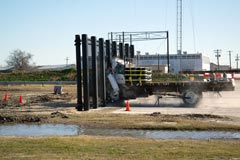In the Middle Ages, gate keepers had it relatively easy. Castles were considered the pinnacle of defensive warfare technology. Then gunpowder was invented, and holes blasted in stone walls caused medieval strategists to reevaluate their old way of thinking.
A similar change has occurred following terrorist attacks of the last 15 years, where the preferred weapon of terrorists worldwide has become the car bomb.
“Anti-ram barriers are typically used around government buildings, infrastructure facilities, military installations or any other location where terrorist activity is a threat,” explains Dean Alberson, program manager and assistant director at the Texas Transportation Institute. “These barriers keep vehicles away from buildings to minimize damage should a car bomb explode.”
In 1985, the U.S. Department of State (DOS) created an anti-ram standard for protecting its embassies. The standard was designed to stop a medium-duty, single-unit truck and accounted for three levels of blast penetration.
Consular facilities are often squeezed into high-traffic urban areas on small lots. So as the new millennium approached, embassy bombings, like those in Kenya and Tanzania in 1998, demonstrated the need for a new standard. In 2003, DOS revised its standard to meet this new threat.
The 2003 standard limited penetration concerns to 3 feet and reconstituted the standard from a gasoline to a diesel truck. Other agencies — like the Department of Defense (DOD) and Department of Energy (DOE) — found the new standard useful…but incomplete.
DOD, for example, kept the original penetration ratings from the 1985 standard, which acknowledged the potential for bombings outside a 3-foot range. (Military bases are typically surrounded by wide open spaces, which create a much greater stopping distance for enemy vehicles.)
“Other concerns cropped up as well,” says Alberson. “The 2003 standard assumed a terrorist would use a 2.5-ton diesel truck to carry out an attack. But recent realities in Iraq, Afghanistan and other countries make it clear that practically any vehicle will do.”
The U.S. Army Corps of Engineers wanted a more flexible standard, so ASTM created a team in fall 2003 to address their need. Led by Alberson, the team developed ASTM F2656-07, Standard Test Method for Vehicle Crash Testing of Perimeter Barriers, that reintroduces more penetration ratings, adds design flexibility to cover a wide range of vehicles and specifies different impact velocities for some vehicle categories.
To meet the standard, vendor barriers must be tested by an accredited laboratory like TTI‘s Proving Ground Research Facility. The facility then issues a mandatory report on how the equipment performed. DOS adopted ASTM F2656-07 in October 2008 and activated it Feb. 1, 2009.
“The leadership role that TTI had in the development of this consensus test standard will ultimately help ensure the protection of American lives at home and abroad,” acknowledges Ed Conrath, a senior principal with Protection Engineering Consultants. Conrath oversaw ASTM F2656-07 development.
* Not included in the original article: The TTI Proving Ground is an International Standards Organization (ISO) 17025 accredited laboratory with American Association for Laboratory Accreditation (A2LA) Mechanical Testing Certificate No. 2821.01.


